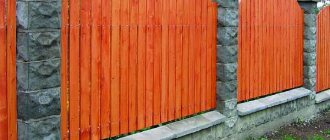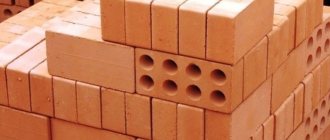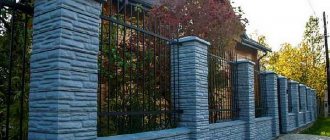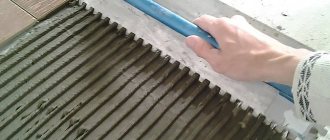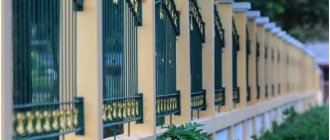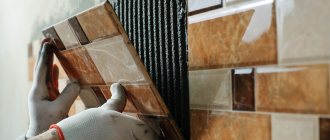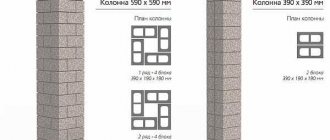You already know that fence supports can be made using different materials. It could be: brick, wood, metal . How to paint the stove after plastering with tile adhesive? Fence posts can be painted using specially developed products for each type.
This is both a decorative treatment and protection from various external factors.
Painted metal fence post Return to contents
The process of painting poles and wooden fences
Don't forget about impregnation, which will protect the pillars from high humidity.
This process requires special care. It is necessary to work with them before installing the pillars. The part of the pillars that will be in the ground should be treated with bitumen impregnation. All operations should be aimed at extending the service life of structures.
Bitumen impregnation will contribute to the resistance of the fence base to water, alkaline and acid reactions. It is advisable to repeat this procedure twice with a break of a day.
The bitumen layer must be hard. Also, try to dry the posts before painting. Humidity should reach 15%! Why should this be done?
Because the wood will always be in contact with moist soil. And so, when painting dry wood, the moisture content of the wood is adjusted. Be sure to sand the surface of the wooden fence.
This will reduce the amount of impregnation used and better protect the wood being treated.
Never perform such operations in wet weather. The top of the posts is treated with varnish with an ultraviolet absorber or other paint that you prefer.
These fence posts can be painted using several options. The simplest and least expensive is coating with bitumen varnish. The varnish can be diluted and evenly applied to the posts. Drying takes three to four hours.
The posts will have a shiny black color. You can simply use metal enamel. How to paint plastic plinth for PVC panels?
But this method is short-lived.
Paint “Special Forces”
The most expensive and reliable method is considered to be treating the surface of poles with Spetsnaz paint. It is advisable to work with a small brush.
This process requires following simple rules, under which you will achieve good results:
- To get started, you need to prepare your workspace. It is advisable to paint on a warm and dry day.
- There should be no vegetation near the pillars.
The process of painting metal fence posts
- Take solvent and a rough brush and remove the oil layer from the surfaces. If there is rust or oxidation on the pillars, then they also need to be removed.
- If the poles are dirty, make a soapy solution, wash them, and then rinse them. After this, dry and remove any existing rust.
- Degrease with white spirit.
- The advantage of this paint is that the surface of the pillars does not need to be primed. This paint is applied two to three times. After drying each layer.
By the way, Spetsnaz paint can also be diluted with solvent 647. There are 900 g of paint in a can. Therefore, it is quite possible to paint 12 pillars.
We recommend: Scope and properties of ceramic paint
Try to purchase such products only in specialized stores.
Other processing methods
Some owners simply prime the pillars with GF-021. Based on their experience, they state that although coating in this way is cheap, it has good protective and decorative properties.
You can combine primer with paint. Apply primer to the surface. Let it dry. After that, work with the paint. You can also use options for painting, choosing from oil, alkyd, acrylic, and polyvinyl paints.
All of them have good contact with metal structures.
Be sure to have a water-based degreaser, a brush with coarse bristles, and a wire brush in your arsenal. You can also buy paint based on epoxy resin. Don't forget the solvent.
Rules for painting fences and posts
- Windy and rainy weather is not suitable for painting the fence.
- The scorching sun is not the best condition for painting.
- Paint on a cloudy and dry day.
- Apply primer first, then paint after completely absorbed.
- First the pillars are painted, then the entire fence .
- For inaccessible areas of the surface, use brushes.
For accessible ones - sprayers or other devices.
- Be sure to paint the joints and grooves well.
- Paint only with high-quality materials.
- Before painting metal surfaces, it is necessary to treat them and remove rust so that it cannot spread under the paint layer.
- Try to apply a primer and after it dries, start painting. Experts advise applying the primer three times.
- You don’t have to treat concrete pillars with anything, just paint them. The only thing you can do is to clean the posts, like the entire fence, from dust with a brush.
- Follow the instructions when painting.
- Galvanized poles are coated with epoxy resin paint. It dries within two hours. After this, apply another coat of paint.
- Aluminum and galvanized structures are coated with dispersion solutions.
If you decide to make the pillars white
This is a very complex color. In this option, it is necessary to approach priming and cleaning with special care, because all defects will appear. It is better to use paint with a whitening effect if you want to paint wooden posts. In general, use dark colors. On such surfaces, distortion is less visible.
Try to make the fence delight both you and passers-by with its beauty and well-groomed appearance.
Additional Information:
- Posts to be painted must be clean and dry. If they are dirty, they should be washed with soapy water and rinsed with clean water.
- After the pillars have dried, use a brush to remove rust from their surface.
- Cleaned supports should be wiped with a cloth soaked in solvent. This will allow you to degrease the surface before applying paint.
- If the bitumen varnish is very thick, it can be dissolved in white spirit.
- Apply varnish to the surface of the post with a brush. After four hours it will be completely dry and the pipe can be touched.
Transverse logs are attached directly to the pipes by welding, or guides for fastening are welded onto the pipes. The guides can be made in advance by welding them to a clamp, which is put on the pipe and tightened with a bolt. With this installation option, an insulating pad made of cotton material or a special plastic lining suitable for the diameter of the pipe is placed under the clamp.
Before painting, the metal surface should be primed. For this purpose, GF-021 or similar ones are most often used. How to paint metal fence posts to prevent them from rusting? Its color is gray and red-brown.
To reduce the amount of paint used, a more suitable primer is selected. It is applied to a dry, clean surface with a brush, roller or using a spray gun in 1-2 layers. After the primer has dried, begin painting. To prevent the primer from showing through, the paint will have to be applied in two layers.
If the fence posts are treated with antiseptics before it is installed, then it must be painted after installation. Before applying the paint composition, you should make sure that the fence support posts are dry, there are no bugs in them, and there are no traces of mold on their surface. Before painting, each post is thoroughly wiped with a rag and, if necessary, treated with an additional layer of antiseptic.
How to paint a metal fence: types of paints
The coating for the fence must have the following properties:
- adheres well to the surface of the product;
- be resistant to moisture.
withstand temperature changes
Modern industry produces various paints and varnishes for painting metal fences.
Oil paints for metal
Experts do not recommend using oil-based compounds for painting metal fences, as they have the following disadvantages:
- The coating takes a long time to dry after application;
- the pungent odor of the mixture is harmful to health;
- under the influence of the sun, the paint quickly fades, cracks and peels off;
- Only exactly the same composition is placed on top of the oil.
The only advantage of this material is its low cost.
Alkyd paints
Alkyd enamel is well suited for painting a fence made of ferrous, non-ferrous and galvanized metal. The main advantage of this mixture is its high adhesive ability. However, with strong heating (for example, due to direct sunlight), this composition is destroyed and ceases to protect the metal surface of the fence.
Acrylic materials
The most durable paint for metal is acrylic. The coating practically does not suffer from exposure to light, heat and moisture and retains its fresh color and integrity for many years.
It is safe for human health, does not ignite and does not crack (the paint forms an elastic film).
Products with anti-corrosion properties
If you are going to paint a rusty fence without completely removing corrosion from the metal surface, you can use special paints and varnishes. These compositions contain anti-corrosion components and rust converters, which makes it possible to paint fences made of cast iron, ferrous metals and steel with such enamels without treating them separately with a primer.
At the same time, it remains necessary to remove dust, dirt, grease stains and traces of old substance from the product being painted, since any coatings are applied to a cleaned surface.
Forge paint - stylish and durable
This is the best composition for painting metal fencing. It provides a durable coating that is not afraid of either mechanical or chemical stress. High humidity and sun rays cannot damage it for many years.
After application, the paint dries within 1 hour at a temperature of +20...+25°C, and even faster in hot weather.
The main feature of forge enamel is that it can only be combined with primer and solvent of the same brand, otherwise the result of painting is unpredictable.
The main disadvantage of this material is its high cost.
Hammer paint - expensive and reliable
This enamel forms a beautiful pattern on the painted surface, reminiscent of embossing. This composition adheres firmly to the product, and if in the future you want to remove it and repaint the fence, it will require a lot of effort and the use of special tools and chemical removers.
Recommendations from the experts
In order to paint the fence once and not return to this issue for many years, it is recommended to follow the indicated tips:
- It is not recommended to prime metal surfaces with a roller, due to its ability to drive excess air and moisture into the primer - as a result, the fence will quickly rust.
- The optimal temperature for performing work is +5+40°C, humidity level is from 80 to 85%;
- You cannot add too much solvent to the paint - the paint layer will cover the fence with a thin transparent layer.
- A roller and brush will not be able to provide an equally shiny and smooth layer on par with a spray gun.
Before choosing what paint to paint a fence with, it is worth remembering the most important thing: the process of covering a metal fence with a protective and at the same time decorative layer requires studying the types of materials and technologies for their application. Fence paint can prevent metal corrosion or improve the physical parameters of the structure in cases where it makes sense to go over previously formed rust.
What type of paint to choose
To properly paint a metal fence, you need to use paintwork materials that are resistant to temperature changes and have a level of adhesion sufficient to firmly secure the coating to the product.
The following criteria exist for selecting a suitable mixture:
- barrier material;
- climatic conditions in which the fence will be used;
- financial capabilities of the buyer.
To paint galvanized metal fences, you can use acrylic or alkyd paint (these compositions apply to almost any material). The ferrous metal fence can be well painted with anti-corrosion or oil-based material. Non-ferrous metals should be coated with paints based on epoxy resin or polyurethane.
Metal Fence Colors and Decorative Effects
The palette of metal paints produced by modern industry is not limited to ready-made compositions. You can create the desired shades yourself by adding colors to the purchased mixture or combining enamels of different colors. Computer programs have been developed that allow you to calculate the ingredients to obtain a particular shade.
The finish on your fence can be glossy or matte or semi-matte. Modern paints and varnishes make it possible to create various decorative effects on metal products - the illusion of antiquity, deformation, etc.
Stylish aging of a metal fence
To give the fence an antique style, you can use acrylic compounds that imitate oxidized bronze, copper, brass and even gold. Such paints, like any other, fit well on a prepared surface, and are best applied with a brush.
The maximum aging effect is achieved after treating the product with craquelure varnish (on top of the paint) - it forms picturesque cracks, giving the fence an antique look.
Imitation of patina can also be achieved if, 2 days after painting the fence with the main composition, you cover it in some places with special paints with a greenish tint. The effect of metal oxidized over time on a dark surface is especially pronounced.
Rust resistance test
To evaluate the effectiveness of rust protection paint, you can perform the following test:
- apply paint in accordance with the instructions to a sample made of the same metal as the fence;
- wait several days until the coating dries completely;
- place the sample in a saline solution prepared at the rate of 10 tbsp. l. kitchen salt per 1 liter of water;
- observe until signs of corrosion appear on the test item.
It is useful to conduct this experiment with different paints to compare the quality of different paints.
Primers for metal
The best method for painting steel exteriors is a two-coat system using primer as the first coat and acrylic latex paint as the top coat. High-quality metal primers contain rust inhibitors, which help prevent corrosion.
These primers must be applied before painting iron fence posts as a base coat. Then you need to let them dry completely before applying the finishing paint.
Tips on how to paint a metal fence
Preparing the surface of a metal fence is a stage on which the quality of painting directly depends.
First of all, it is necessary to clean the product from dirt, layers of old paint and remove loose corroded areas from it. Then you need to use a rust converter, which is applied with a spray gun, roller or brush.
You can degrease the parts to be painted using solvent 647.
Some compounds are applied only to the primed surface. It should be borne in mind that a roller is not suitable for treating metal with primer, since it “airs” the mixture and thereby contributes to the formation of bubbles and cavities, under which there is no adhesion of the enamel to the surface.
Fencing made of galvanized metal must be washed with ammonia before painting.
To add richness to the color of the fence coating, experts use tinted primer that matches the color of the base layer.
It is best to apply primer and paint at an ambient temperature of +25…+27°C.
Required Tools
Paint is applied to the fence using a brush, roller or spray gun.
The brush is convenient to use for painting narrow or rounded elements: ends, rods, curls, etc. It is best to take a brush with medium-hard bristles.
The roller should be applied to small flat surfaces.
If you have to paint a very large fence, then you should use a spray gun.
Preparatory operations with paint
If, after opening a jar of enamel, you see lumps or film in it, then this composition will not be able to provide high-quality painting of the fence - it should be thrown away.
Before use, the coloring mixture must be thoroughly mixed; for this you can use an electric drill with a special attachment or a stick.
It is allowed to mix paints of different colors, but of the same type, to obtain the desired shade.
To avoid thickening or drying out of the composition, you should pour the paint from a larger container into a smaller one and add it there as needed.
Application technique
Metal fencing must be painted in 2 layers with an interval of 24 hours. In this case, they must be applied with movements from top to bottom.
Paint on fences made of non-ferrous metals adheres well to a special substrate, the purpose of which is to improve the adhesion of the base composition to the surface. If the fence is assembled from several sections, it is convenient to coat them before assembly.
Rust removal
On the surface of a metal fence, as a result of natural factors (rain, sun rays), rust and a light green coating appear, that is, a patina, creating an antique look. Before starting painting, it is necessary to remove rust and patina, because they will soon begin to penetrate the paintwork and can lead to peeling of the paint.
Before painting an iron fence, so that it does not rust later, it is necessary to carry out anti-corrosion treatment. You can remove rust yourself. If the rust has penetrated too deeply, removing plaque at home is too difficult, and you will have to pay for cleaning at a specialized workshop.
You can remove rust yourself using a rust remover, for example:
- Fosol,
- Epoxy,
- Rust filler.
In more complex cases, the work is done using a grinding machine with a grinding wheel installed, as shown in the photo.
If corrosion is noticed in time, the rust can be removed using a wire brush. This is possible if the rust creates only a superficial coating that is not difficult to remove.
For cleaning you can use:
- wire brush,
- sandpaper (120-240).
There is no need to clean the surface down to bare metal. All traces of rust and layers of paintwork should be removed if they could potentially come off along with the new paint that you intend to use for painting.
What types of metal poles are there?
Pipes having the following types of sections are usually used as metal fence supports:
Pipes with a round cross-section have a low cost. The height of this type of pipe varies from two and a half to four meters, and the diameter ranges from 57 to 108 millimeters.
Pipes with a square cross-section are easier to install, and due to the presence of stiffeners, they are more reliable. For them, you do not need to purchase plates that act as a stabilizer. The wall thickness of such pipes is 2–4 mm.
Pipes with a rectangular cross-section have the same properties as pipes with a square cross-section; they differ only in their design.
In the production of metal poles, the method of internal and external hot-dip galvanizing can be used, which increases the service life of these products. The thickness of galvanizing is usually 135 microns. The thickness of the polymer coating most often ranges from 65 to 90 microns.
The strongest and most durable are metal poles that are both zinc and polymer coated.
For waterproofing, metal caps are attached to metal pipes.
The cost of metal supports directly depends on its quality and service life of the product and is calculated per linear meter.
Compositions for preparation before painting metal
Special materials are used for preparatory work. Among them are enamel primers 3 in 1, which are applied to rusty surfaces. The presence of special components in the composition transforms surface corrosion on the metal. Also contributes to subsequent rust protection.
To protect metal parts from a damp environment, for example, when a pole is immersed in the ground, bitumen mastic and bitumen varnish are used. The compositions have high adhesion and can be applied without prior priming of the iron.
Before painting the post into the ground, you need to treat the metal supports with rust converters. They turn corrosion into a phosphate film, protecting the metal from subsequent rusting. Bituminous varnish can be applied as an additional topcoat, giving the supports an attractive shine.
Painting wooden fence posts
The processing of wooden poles is carried out with special care, and the lower part, which should be in the ground, must be lubricated with resin.
The procedure for painting posts and sections of a wooden fence
This precaution will extend the life of the supports and, accordingly, the entire fence. Treatment of underground parts of supports can be carried out with means that contain bitumen. When choosing a product, you must carefully read the instructions for use. In some cases, before applying bitumen impregnation, it is recommended to lubricate lumber with corbolineum.
They are able to regulate humidity in wood, are resistant to precipitation and exposure to direct sunlight. To treat wooden fence posts you will need:
- Broom;
- A piece of flannel fabric;
- Rubber gloves;
- High-quality paint for exterior decoration;
- Brush No. 4;
- Brush No. 1;
- Angled brush.
If the fence posts are treated with antiseptics before it is installed, then it must be painted after installation. Before applying the paint composition, you should make sure that the fence support posts are dry, there are no bugs in them, and there are no traces of mold on their surface. Before painting, each post is thoroughly wiped with a rag and, if necessary, treated with an additional layer of antiseptic.
Wooden fence posts should only be painted with special paints, oils or varnishes. Such products contain ultraviolet radiation absorbers and protect the tree from the destructive effects of moisture. A layer of paint is applied evenly on all sides of the support. After the first layer has dried, apply the second layer. For effective application, you should use different brushes that will help paint even hard-to-reach places.
General rules for painting work
It is recommended to paint metal products after applying primer.
Step-by-step instructions for coloring are the same for all compositions. When using universal or powder paint, preparatory work can be neglected.
- Support posts, gratings, and corrugated sheets are cleaned of dirt, dust, and grease stains. The latter are removed with acetone or solvent.
- After drying, the surfaces are treated with a primer. The next day the procedure is repeated. Primer is carried out only in dry weather.
- The paint is applied with a brush, roller, or a spray gun. In this case, the face is protected with a mask and goggles, gloves and an apron are put on.
- It is recommended to apply the coloring composition a second time after the first layer has completely dried.
- The coating dries from 4 hours to 2 days depending on the type.
Painting the metal elements of a fence not only increases its attractiveness. Paint protects iron from rust and extends its service life.
DIY installation of metal poles
The most practical option for use as supports are metal poles with a square cross-section, measuring 60 by 60 millimeters. Such supports can easily support the weight of a three-meter high corrugated board fence, not to mention lighter wooden structures.
To install the support posts, the following tools are required:
- shovel;
- sledgehammer;
- roulette;
- paper;
- pencil;
- building level;
- welding machine;
- twine;
- wooden pegs;
- crushed stone;
- sand;
- cement.
What types of metal poles are there?
Metal fence posts should be treated with paints not only for beauty, but also to protect against corrosion.
Example of a painted metal fence post
An affordable and simple way is to apply bitumen varnish or special metal enamel to the surface of the support. Applying enamel requires preliminary impregnation of the surface of the pillar with a primer. This preparation of the metal will extend the durability of the enamel.
To process metal supports you will need a wire brush and a small brush. Stages of work:
- Posts to be painted must be clean and dry. If they are dirty, they should be washed with soapy water and rinsed with clean water.
- After the pillars have dried, use a brush to remove rust from their surface.
- Cleaned supports should be wiped with a cloth soaked in solvent. This will allow you to degrease the surface before applying paint.
- If the bitumen varnish is very thick, it can be dissolved in white spirit.
- Apply varnish to the surface of the post with a brush. After four hours it will be completely dry and the pipe can be touched.
Processing pipes with enamel requires a preliminary primer. To apply to metal fence posts, you can use primer GF-021. It is applied in an even layer over the entire surface of the product cleaned of dirt. After the primer has completely dried, enamel is applied to the posts.
The lower part of the pillar, which will be in the ground, is covered with bitumen mastic.
The poles can be painted both before and after installation. If you decide to paint the poles before installation, remember that the coating may be damaged during installation, and it is easier to paint on all sides in a vertical position.
The coloring process occurs in several stages:
- Preparation of the surface to be painted: removal of dirt, dust, old coatings.
- Removing rust using special tools and sandpaper or an abrasive brush.
- Applying primer.
- Painting in two layers.
Currently, three-in-one paints have appeared.
They can be applied even to an unprepared surface without removing rust. But reviews from people who have used such paints are not always positive. It often happens that this type of coating is of poor quality, and its cost is quite high. Therefore, it is better to trust proven materials and painting methods.
You need to use paint that is intended for coating metal products and outdoor use.
Corrosion
Metal corrosion is a natural phenomenon that cannot be completely prevented, but this destructive process can be significantly slowed down. The oxidation process occurs with the participation of oxygen and aqueous solutions containing acid, alkali or salt.
Iron is not found in nature in its pure form, but is found in iron ore. Humanity invented the production of steel and came up with ways to preserve it. Factories use methods of phosphating steel by immersing it in various solutions, as well as electrochemical treatment. This coating is in the nature of a primer and requires subsequent painting. Steel is coated with other metals. Cheaper ones are aluminum and zinc.
There are silicate coatings - these are different types of enamel. Enamel is fragile and not entirely suitable for a fence. Cement has approximately the same expansion temperature as steel and serves as an insulator against aggressive environments. Good insulation is a polymer film applied in several layers in the factory.
Choosing a mounting method
In order for the fence to be of high quality and durable, it is necessary to take into account the freezing depth and soil type when installing it.
If the soil on which the fence is installed is sandy and light, then the posts can be installed using the screwing or hammering method.
The driving method is very simple and involves hammering the post into the hole with a sledgehammer. The main thing is not to forget to control the evenness of the installation using a building level.
The screwing method is more complicated. To do this, you need to weld one or two screws to the end of the pipe and screw it into the hole. It is better to take a round and thin pipe. When using this installation method, you must definitely think about how the supports will be dismantled.
If the soil is marshy, then to install metal pillars you will have to make a strip-type foundation, which also needs to be strengthened, and the pillars themselves must be protected as thoroughly as possible from possible corrosion.
In the case of heaving soil, it is necessary to use the butting or partial cementing method.
Attention! The installation depth of the supports should be at least one third of the height of the fence and should be no higher than 20 cm from the frost line. If the fence is 2.5 meters high, then the depth of digging of the support pillars should be half its height!
Let's consider the process of installing metal supports using the example of a fence installed on heaving soil.
Before installing the supports, they take measurements of the area and draw up a plan for the location of the fence, indicating the data obtained on it, as well as the places where the gates, gates, support posts, etc. will be located. Then the perimeter is marked using wooden pegs and twine. First you need to install pegs in the corners of the future fence, then in those places where the gate and gate will be located, after which the location of the intermediate supports is noted. The distance between supports should be no more than 2.5 meters.
If the distance is made greater, the fence will sag and lose its resistance to the wind. If you want your fence to be not only strong and durable, but also beautiful, then the distance between all posts should be equal.
Where the greatest load will be placed on the poles, for example, at the installation site of a wicket and gate, it is worth using the most durable type of pipe.
When everything necessary for installation is prepared, you can proceed directly to the installation. The first step is to install the corner supports. To do this, holes are dug with a diameter of no more than 40 cm. Sand mixed with stones is poured into the bottom of this hole in a layer about 5 cm thick.
Next, install a post in the hole and level it using a building level. The post is secured using the butting method.
This method consists of doing the following: In the hole in which the support will be installed, crushed stone is poured on top of the sand-stone mixture (a layer of 15-20 cm), compacted tightly and watered with water. Then another layer of crushed stone is poured and again it is compacted and watered. In this way, layers are poured until 15–20 cm remains to the soil surface. After filling each layer, it is imperative to check whether the pillar has tilted. The remaining centimeters to the surface are filled with concrete.
On heaving soil, crushing is used because crushed stone easily allows groundwater to pass through itself, which begins to move during periodic freezing and thawing, while water cannot penetrate through cement.
The next step is to install supports for attaching the wicket and gate. As already mentioned, these supports will be subject to quite a heavy load, so you should choose the strongest possible pillars. Also, in order for these supports to stand as reliably as possible, they can be dug deeper than the rest.
When the corner supports and supports for fastening the wicket and gate are installed, you can begin installing the intermediate metal posts.
When installing metal support posts, it is worth constantly monitoring their height, linearity and levelness.
If the installation of supports is carried out efficiently, the fence will delight you with its beauty and reliability for several decades.
Bitumen mastic
Bituminous mastic is widely used in various construction works as a protective and waterproofing material. In the case of support pillars, it is necessary to process that part of the pipes that will be buried or cemented. This will help protect the metal from water and salts dissolved in it. Fence support posts can be painted prior to installation. At the same time, the drying time increases, since the lower plane is not painted, and it is simply difficult to work with round material. In addition, the finished surface can be damaged quite easily. Therefore, it is better to apply paint after installation.
If welding work is expected, then the coating must be applied after completion, carefully cleaning the weld seams!
For ferrous steel, solvent rinsing is used without subsequent water rinsing. What kind of fence posts should I use? To degrease, you can wipe it with a rag soaked in white spirit and let it dry. It is not recommended to use solvent for degreasing galvanized surfaces.
It is better to wash the posts and joists with soap and water. Then rinse with clean water and wipe dry.
Painting brick pillars
Over time, brick fence posts may lose their attractiveness and become covered with a white coating. Treating such posts will help refresh the fence and prolong its service life. For fence posts, you can choose elastomeric paint. This product is applied to the surface to be treated in a thick layer, which protects the surface of the brick from damage.
Option for painting a brick fence and pillars
- The brickwork should be cleaned of dirt and white deposits (salt deposits). In case of severe contamination, it is recommended to use a solution of hydrochloric acid. You need to work with it wearing protective gloves, goggles and a respirator.
- Using a stiff brush, remove all dirt from the surface.
- If cracks are found on the pillars, they will need to be cleaned from dust with a vacuum cleaner and sealed with silicone or acrylic putty. Sometimes it becomes necessary to apply a second layer of putty after the first has dried (after five hours).
- If mold is found on bricks, it must be removed, for example, using household Domestos.
- Brick can be coated with a primer before painting. For this, it is best to use a latex primer.
- Elastomeric brick paint is suitable for painting brick pillars. This product contains a large amount of acrylic.
Today, a large number of products are produced for processing and painting fence posts made from a wide variety of building materials. Anyone can match them to their fence and apply them to the surface of posts or sections. In order for the result of the work to meet expectations, you need to select paint that strictly matches the material of the support.
Asbestos-cement structures
Pillars made of this material are the cheapest option for such products. They do not have an attractive appearance, and they also do not have very good characteristics. But they are not at all afraid of high humidity. It is not necessary to paint these structures, because they can already last for more than ten years.
But painting will give a better appearance to such structures, which is exactly what they lack. If such pillars are filled with concrete, their service life will increase several times more. Below we will describe some paintwork materials that are suitable for painting poles made of this material:
- Coatings for Shikril slate. They can only be painted on a completely dry and clean surface. This product must be diluted with a solvent according to the manufacturer’s instructions. You will have to wear personal protective equipment to work, as this composition is toxic. This material is not afraid of moisture, frost, very durable and elastic.
- Kilpi products from Tikkurila. It has many positive qualities, but it is especially worth highlighting that it is not at all afraid of low temperatures. The consumption of such a product will be approximately 500 g per 1 sq.m.
- TM Dachbeschichtung from the manufacturer Dufa. An important feature is that it has the best level of adhesion (adhesion to the surface). And the consumption is no more than 150 g per 1 sq.m.
- Akrilakma product from the manufacturer Lakma. The consumption of this paint is 170 g per 1 sq.m. And it dries in about one hour.
- TM Polifan from the manufacturer Polifan-L. The consumption of this substance is about 350 g per 1 sq.m.
